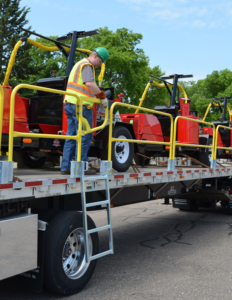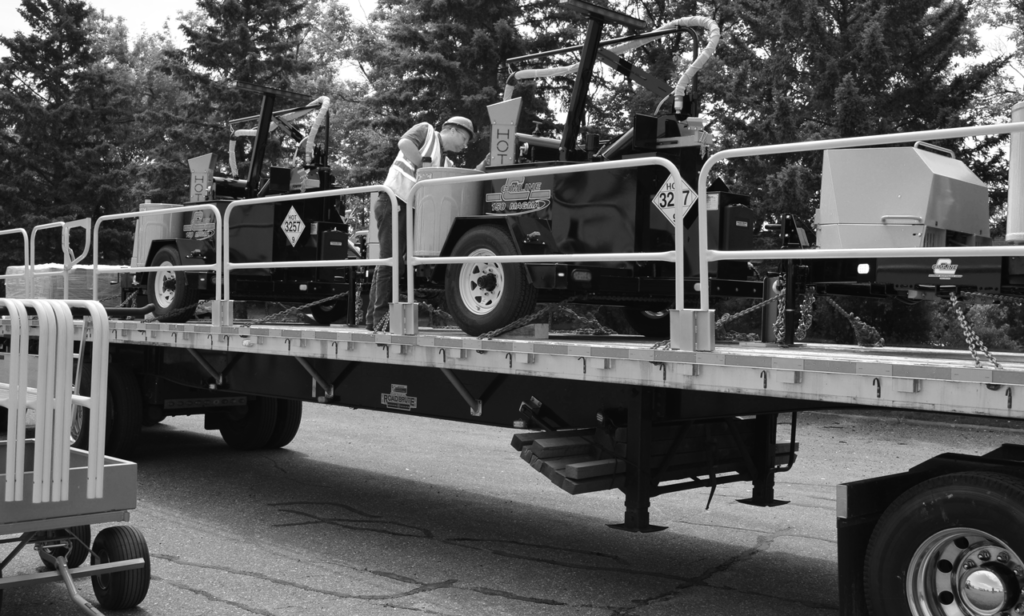Did you know that 40% of fatal falls occur at a height of 10 feet or less? Falls from flatbed trailers cause countless injuries and fatalities. Drivers are tasked daily to access their flatbed trailers for a variety of reasons including loading/unloading, securing cargo, or simply routine maintenance. Protect your employees and business by assessing current safety procedures to ensure you are following all federal guidelines.
OSHA and DOT Regulations
The Occupational Safety and Health Administration (OSHA) and the US Department of Transportation (DOT) set forth standards and regulations for the transportation and trucking industries. OSHA has the authority to regulate occupational safety and health while the DOT has the authority to regulate commercial motor vehicles. DOT regulations address fall protection for persons entering or exiting the cabs of trucks while OSHA regulates fall protection from other areas of the vehicle.
In January of 2017, OSHA updated their standards relating to fall protection and safety.
General Industry Standard 1910.28(b)(1)(i) states:
“. . . employers must ensure that each employee on a walking/working surface with an unprotected side or edge that is 4 feet or more above a lower level is protected from falling by one or more of the following: (A) Guardrail systems; (B) Safety net systems; or (C) Personal fall protection systems, such as personal fall arrest, travel restraint, or positioning systems.”
Construction Standard 1926.501(b)(1) states:
“…employees on a walking/working surface (horizontal and vertical surface) with an unprotected side or edge which is 6 feet (1.8 m) or more above a lower level shall be protected from falling by the use of guardrail systems, safety net systems, or personal fall arrest systems.”
How can you protect your drivers and business?
When it comes to fall protection and safety, minimize the risk of potential injury by first performing a risk assessment for all tasks involving work on top of trucks or trailers.
Consider the following:
- Nature and duration of each task
- Physical surroundings and conditions
- Equipment, tools, and materials used
Once these potential fall hazards have been identified, determine if any tasks could be performed at ground level. Many fuel and bulk liquid tankers are equipped with tank fittings arranged so all loading and unloading can be completed at ground level.
For tasks that cannot be completed at ground level, there are several fall protection systems that meet OSHA requirements:
- Guardrail systems
- Mobile loading platforms
- Personal fall protection systems, such as personal fall arrest, travel restraint, or positioning systems
Guardrail systems attach directly to trucks or trailers and are designed to include both a top and mid rail. No training is required to utilize this type of fall protection system. There are, however, weight and size limitations.
Mobile loading platforms provide a non-slip work surface with guardrails that can be positioned as needed for a variety of tasks. Prefabricated platforms are available, making this type of system less expensive than permanent platforms.
Personal Fall Protection Systems (PFPS) are comprised of 3 components: body harness, connecting device, and an anchor. While considered a less expensive option to the guardrail system, effectiveness is entirely dependent on proper use and installation of the PFPS equipment. Training is required to ensure components (especially the anchors) are installed properly.
Here at Garlock Safety Systems, we offer flatbed fall protection systems that feature safety guardrail kits which install quickly into standard trailer pockets.
 Our SpeedGuard and SpeedGuard II flatbed fall protection systems include drop-in rails that install directly into stake pockets to provide full perimeter fall protection for the bed of the truck. Both systems are OSHA compliant and install in under 15 minutes on most trailers. A rolling stairway or ladder depending on the systems allows for safe access to the trailer and storage of the system between uses.
Our SpeedGuard and SpeedGuard II flatbed fall protection systems include drop-in rails that install directly into stake pockets to provide full perimeter fall protection for the bed of the truck. Both systems are OSHA compliant and install in under 15 minutes on most trailers. A rolling stairway or ladder depending on the systems allows for safe access to the trailer and storage of the system between uses.
Be Proactive
Rather than waiting until an injury has occurred, take a proactive approach to ensure the safety of your employees and minimize injuries in the workplace. Implementing a fall protection plan will not only protect workers from injury, but will substantially reduce workers’ compensation claims, increase productivity and eliminate potential OSHA violations.
